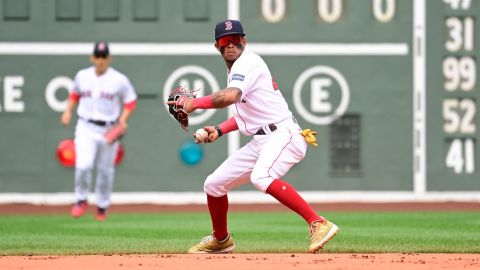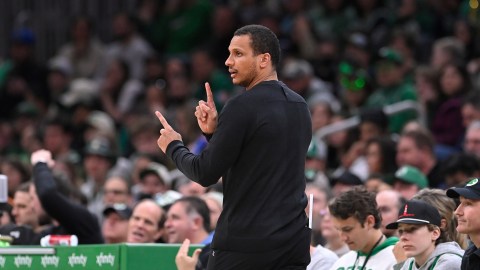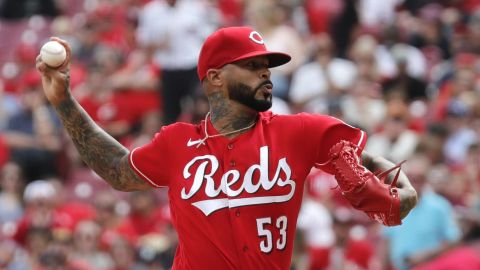 Many moons ago, before he eventually returned as the skipper, John Farrell served as Red Sox pitching coach. For four seasons, he worked with a closer by the name of Jonathan Papelbon. Maybe you remember him. But even those four impressive years by Papelbon aren’t enough to cloud Farrell’s vision of just how good Koji Uehara has been in 2013.
Many moons ago, before he eventually returned as the skipper, John Farrell served as Red Sox pitching coach. For four seasons, he worked with a closer by the name of Jonathan Papelbon. Maybe you remember him. But even those four impressive years by Papelbon aren’t enough to cloud Farrell’s vision of just how good Koji Uehara has been in 2013.
“No. I haven’t,” Farrell said Friday when asked if he has seen a closer go through a stretch like the one Uehara is currently enjoying. “Whether it’s someone with a previous club, no. In a word, no.”
Uehara started the season as Boston’s setup man. He was basically fourth on the team’s closer depth chart behind Joel Hanrahan, Andrew Bailey and Junichi Tazawa. Injuries and inefficiency have since cleared a path for Uehara to become the Red Sox’ ninth-inning man, and the 38-year-old has been nothing short of lights out.
Uehara enters Saturday’s game with a 23-inning scoreless streak after recording a four-out save in the Red Sox’ 4-3 win over the White Sox on Friday. The streak spans 20 outings, with Uehara last surrendering a run — which was unearned — on July 6 against the Angels. (Brandon Snyder made a costly error in that game as the Angels scored four runs in the ninth inning and eventually won 9-7 in 11 innings.)
The 23-inning scoreless streak is the second-longest active streak in the majors behind Craig Kimbrel’s 24 1/3-inning mark, and it’s the longest of Uehara’s professional career, including Japan. Uehara has only allowed seven baserunners during his streak, and 13 of his 15 saves this season have been perfect.
Uehara vowed upon being named closer that he wouldn’t alter the just-throw-strikes mentality that made him a premier setup guy, and he’s been a man of his word. Uehara has been as efficient as it gets this season, throwing a first-pitch strike 69.9 percent of the time, which ranks fifth among relievers. Batters have swung and missed at 17.2 percent of Uehara’s strikes, good for the best mark in baseball.
 Uehara’s efficiency is a beautiful thing. Not only does it keep him from pitching himself into trouble, but it gives the Red Sox some flexibility. Uehara recorded four consecutive outs Friday, and while Farrell would prefer to use his closer for only three outs, the veteran’s knack for pounding the strike zone ensures that his pitch count doesn’t skyrocket over the course of a given outing.
Uehara’s efficiency is a beautiful thing. Not only does it keep him from pitching himself into trouble, but it gives the Red Sox some flexibility. Uehara recorded four consecutive outs Friday, and while Farrell would prefer to use his closer for only three outs, the veteran’s knack for pounding the strike zone ensures that his pitch count doesn’t skyrocket over the course of a given outing.
“Over the past month, I think he’s averaging somewhere around 12, 13 pitches an inning in those closing situations,” Farrell said Friday. “Knowing that an out in the previous inning, even if that keeps us away from using him [Saturday], I just thought it was a pivotal time to record the final out [of the eighth inning Friday] against the middle of their lineup, their power in that situation. But yeah, his efficiency certainly lends to the ability to go to four outs.”
The last time that Uehara surrendered an earned run was June 30, when Jose Bautista took him deep at Fenway Park. His ERA has dropped from an impressive 2.12 to a dominant 1.19 in that span, and he is only the fourth pitcher in Red Sox history to record 20 consecutive scoreless outings — joining Daniel Bard (25 in 2011), Papelbon (21 in 2011) and Ugueth Urbina (20 in 2002).
So what does this all mean? If you’re a fan of wins above replacement, you could look to Uehara’s 2.5 WAR — which ranks second to Greg Holland’s 2.6 among MLB relievers — as proof that the Red Sox closer has been the best reliever in baseball this season. You’d probably find a number of guys in the Boston clubhouse who would agree. If you’re a fan of the Red Sox, you could look at Uehara’s accomplishments as proof that his 2013 season might be better than — or at least as good as — any of Papelbon’s seasons in Boston.
For the sake of argument, let’s compare Uehara’s 2013 season with Papelbon’s 2007 season. (We all know how that season ended.) Here’s how they stack up.
Uehara (2013): 3-0, 1.19 ERA (eight earned runs in 60 1/3 innings), 15 saves in 18 chances, 0.63 WHIP, 12.2 K/9, 4.3 H/9, 1.3 BB/9, 9.1 K/BB, 352 ERA+, 2.5 WAR
Papelbon (2007): 1-3, 1.85 ERA (12 earned runs in 58 1/3 innings), 37 saves in 40 chances, 0.77 WHIP, 13.0 K/9, 4.6 H/9, 2.3 BB/ 9, 5.6 K/BB, 257 ERA+, 2.3 WAR
 Papelbon was the closer for all of 2007, so one could argue that his campaign was more difficult to navigate through. According to Baseball Reference’s game-entering leverage index, which measures the average pressure a reliever faces over a given outing or season, Uehara owns a 1.5 mark in 2013, while Papelbon had a 1.8 in 2007 (after a 2.0 in ’06) — above 1.0 is considered high pressure. And according to Fangraphs’ clutch factor, which determines how much better or worse a player performs in high-leverage situations than he would have in context neutral environments, Uehara has a 0.23 mark in 2013 to Papelbon’s 0.36 mark in 2007.
Papelbon was the closer for all of 2007, so one could argue that his campaign was more difficult to navigate through. According to Baseball Reference’s game-entering leverage index, which measures the average pressure a reliever faces over a given outing or season, Uehara owns a 1.5 mark in 2013, while Papelbon had a 1.8 in 2007 (after a 2.0 in ’06) — above 1.0 is considered high pressure. And according to Fangraphs’ clutch factor, which determines how much better or worse a player performs in high-leverage situations than he would have in context neutral environments, Uehara has a 0.23 mark in 2013 to Papelbon’s 0.36 mark in 2007.
There’s plenty of baseball left, and we all know how Papelbon performed in the playoffs. But it’s time to recognize just how dominant Uehara has been this season. Whether you crunch numbers or give it a straight-up eyeball test, Uehara has been one of the Red Sox’ most valuable players all year. And a heck of a bargain at $4.25 million.
The lasting image of the Red Sox’ 2007 World Series campaign was Papelbon leaping into the air after the final out of Game 4 in Colorado. Could a Koji high-five be the next iconic image?
Have a question for Ricky Doyle? Send it to him via Twitter at @TheRickyDoyle or send it here.




